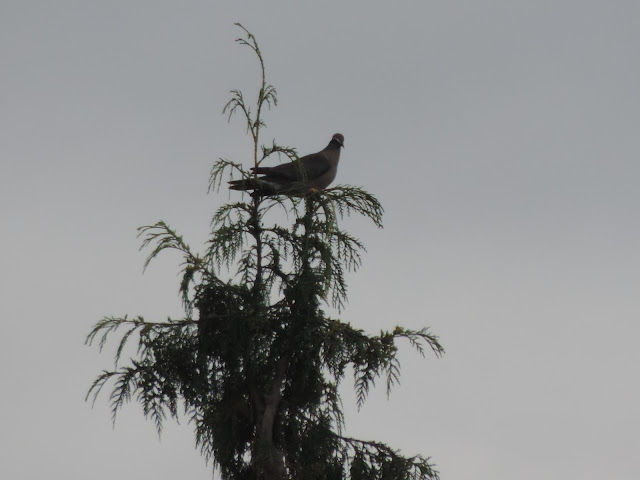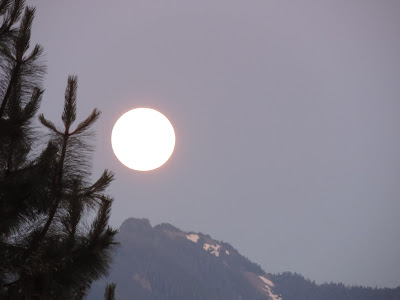Hello, Dear Friends! I hope that you have been staying cool
and dry during this midsummer season of intense
heat and storms.
I am not fond of the heat, what with being a true-blue Northern Gal,
so, I stay inside whenever the temperature gauge rises
above 80 degrees.
Once it cools down in the early evening, I love to go on nature walks
with my Ramblin' Man and our loyal companion, Kai.
I would love it if you came along!
xx
We'll start here, along the cobbled path, where it is shady and cool.
As we come upon Ramblin' Man's toolshed, we find a small stand
of Foxglove growing.
These grow wild here in the Pacific Northwest, with
our mild climate and plentiful rain in the spring.
There are many legends of how these magical (and
deadly poisonous) plants got their name,
but I think it is self-explanatory!
This famous medicinal plant came from Europe
through early settlers. The heart drug, digitalis is derived from
Foxglove.
xx
"Who knows the flower best? - the one who reads about it in
a book, or the one who finds it wild on the mountainside?"
-Alexandra David-Neel-
As we pass the front of the house, we see Tansy.
Looking closer, we can see a little crab spider
munching on his prey.
Every little place has its own balanced ecology if
you take the time to notice.
I discovered wild Tansy growing along some railroad
tracks when we first moved here, many years ago.
We stopped and collected the beautiful golden flowers
to dry for making wreaths.
When I eventually tossed them in the compost pile,
I unwittingly seeded my own little colony in all of my garden beds!
I love them for their ferny, camphor-scented leaves
that I dry for sachets to repel pests,
and the wonderful, everlasting button flowers.
xx
"Despite the gardener's best intentions,
Nature will improvise."
- Michael P. Garofalo -
A 'Black Lampyrid' beetle.
A beautiful Tiger Moth.
xx
"In nature we never see anything isolated, but everything in connection with something else
which is before it, beside it, under it and over it.
- Johann Wolfgang von Goethe -
A Swainson's Thrush and nest.
These shy birds are about the size of a Robin, but
thinner, and are hard to see because they spend most of
their time on the ground in thick vegetation. They feed
on insects and fruit.
Red-Belt Conk recycles wood into soil.
Here it is growing on a fallen Hemlock log.
A Band-Tailed Pigeon takes a good look around.
These are wild pigeons that are quite large -
14 - 15 inches! They form small flocks which prefer
residential areas and city parks
with large conifer trees to nest in, but live a nomadic
lifestyle in search of food consisting of seeds, nuts,
fruit and berries.
Ghost Bramble - named for its beautiful bluish gray
stems. These produce a deliciously sweet black raspberry.
I've 'cultivated' a few in my garden to enjoy the fruits,
lovely color and form.
Vine maple against the massive trunk of a Douglas fir.
xx
"I'm always astonished by a forest. It makes me realise
that the fantasy of nature is much larger than
my own fantasy. I still have things to learn."
- Gunter Grass -
Hedge-nettle.
This is a delicate, tall perennial with tubular flowers
that hummingbirds love. They spread by rhizomes or seeds
and are medicinal. The leaves can be steeped for tea
to relieve headaches and ease joint inflammation.
I've been protecting and nurturing a small stand
in my woodland. Woe to anyone who strays off the path
where they reside!
xx
"The Amen of nature is always a flower."
- Oliver Wendell Holmes -
Kai, our own little force of nature!
Enchanter's Nightshade.
Such an intriguing name.
The Latin name is Circaea alpina, after
the Greek goddess Circe - an enchantress - who supposedly
used this plant 'as a tempting powder in some amorous concerns'.
Imagine - this little plant grows unobtrusively in shady glens
here in my very own woodland!
Fringe cup. They remind me of Coral Bells. They are
perennial and form pretty little colonies under large trees.
Song sparrows serenade us all summer long.
Such sweet music from something so tiny.
Sparrows have white eggs with tiny brown specks.
xx
"One shouldn't go to the woods looking for something,
but rather to see what is there."
- John Cage -
Salmon Berry.
The birds love these, but they are very bland tasting.
They have beautiful rose-colored flowers in spring.
Sword ferns are evergreen and live for years in shady woodlands.
Licorice ferns are perennial and grow in the base and branches of hardwood trees.
The sweet, licorice-flavored rhizomes were chewed for the flavor by
Northwest native peoples and were also an important medicine
for colds and sore throats.
We have many varieties of ferns, including bracken fern, deer fern,
maidenhair fern, lady fern, and shield fern.
xx
"Look deep into nature, and then you will understand everything better."
- Albert Einstein -
The 'locals', a young black-tail buck and a Douglas squirrel enjoying
some maple seeds (samaras).
Ocean spray, a large shrub with several main stems.
Also known as Ironwood because of the strength
of its wood. It was used to make everything from spears
and harpoon shafts to salmon-barbecuing sticks and knitting needles
by virtually all native peoples of the coastal northwest.
An open hillside covered in perennial, wild sweet pea.
Queen Anne's Lace growing with Pearly Everlasting in a grassy area.
Tall stalks of Mullein on the edge of the woodlands.
" Leave the beaten track behind occasionally and dive into the woods."
- Alexander Graham Bell -
Blackberry blooms are very pretty and attract
bees, butterflies and hummingbirds.
A tiny heartbeat with wings.
I held one in my hands once when it became
trapped in my greenhouse window when we were building the house.
I gently scooped it up and
could feel its tiny heart beating wildly.
I like to think that because I saved one,
now I am blessed with many
to brighten my days.
Blackberries have pink blooms in the shade.
A Thimbleberry bloom. The berries are similar to raspberries,
but drier, so they lend themselves to drying. Native peoples
dried them, along with huckleberries and salmon berries,
to make pemmican with salmon or big game.
They grow on shrubby, thornless stalks that form large colonies.
Leaves are large, maple-like, and make great
make-shift berry baskets.
Red Huckleberries. These are so pretty on their lime-green stalks.
They grow on blueberry-like shrubs, usually on rotted tree stumps,
especially cedar.
xx
"At some point in life, the world's beauty becomes enough."
- Toni Morrison -
We have eagles regularly flying over.
They sometimes sit in the tallest tree
and make a hollow, clicking sound like two bamboo sticks
being hit together.
A young Robin being taught how to hunt insects
by a devoted parent.
We had a nesting pair close to the house this year
which raised two broods together.
The male is very territorial and will dive-bomb
anyone or anything that gets too close to the nest.
Shadows are getting long - time to head for home!
I really enjoyed your company, Dear Friends!
Thank you for coming along!
Time to go inside and do a little research on what we've seen.
Some of my many research books.
I am always on the look-out for books to add
to my library on
our local flora and fauna.
Nature needs our knowledge and compassion.
The future of this beautiful planet depends on it.
The sun sets on a beautiful day, turning the hills gold.
xx
"There's a sunrise and a sunset every single day, and
they're absolutely free. Don't miss so many of them.
- Jo Walton -
And as the moon rises above the hills, we reflect upon our day.
xxxx
" May your trails be crooked, winding, lonesome, dangerous,
leading to the most amazing view.
May your mountains rise into and above the clouds."
- Edward Abbey -
"Like music and art, love of nature is a common language
that can transcend political or social boundaries."
- Jimmy Carter -
xxxx
Sharing with: Saturday's Critters
Won't you join the fun?


.JPG)
.JPG)
.JPG)


.JPG)



.JPG)

.JPG)


.JPG)




.JPG)
.JPG)


.JPG)

.JPG)

.JPG)
.JPG)


.JPG)












.JPG)
.JPG)
.JPG)





